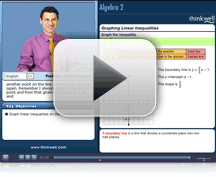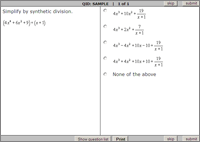Algebra 2
Thinkwell's Algebra 2 online videos have all the algebra help you need in a fun, easy-to-use study aid. Because it covers all of the topics in any typical Algebra 2 textbook, Thinkwell's online Algebra 2 makes solving algebra problems both easy and enjoyable.
Thinkwell's video lessons feature award-winning teacher Edward Burger. Students love Professor Burger's passion for teaching and his sense of humor, as well as his ability to break down concepts and explain each example step by step, all while sharing the tips and tricks that make algebra easy for anyone.
Our complete Algebra 2 package includes:- 12-month Online Subscription to our complete Algebra 2 course with video lessons, automatically graded exercises, and much more.
Money-Back Guarantee
Algebra 2 Materials
Online Subscription, 12-month access
Access to a complete online package that includes everything you need:
- High quality video lessons explain all of the Algebra 2 Math concepts
- Automatically graded exercises with immediate feedback allow you to track your progress
- Subscriptions start when you are ready. Buy now and activate your course anytime you like. Wait up to one year to activate your subscription; your 12-month subscription doesn't begin until you say so!
Algebra 2 Details
Thinkwell's Algebra 2 math includes all of these features for your student:
- Aligned to Algebra 2 National Math Standards
- More than 100 topics with 400+ engaging video lessons
- 750+ interactive exercises with immediate feedback allow you to track your progress
- 28 animated interactivities with audio
- Algebra 2 practice tests and final tests for all 14 chapters, as well as a midterm and a final
- Real-world application examples in both lectures and exercises
- Closed captioning for all video lessons
- Glossary of more than 250 mathematical terms
- Brand-new content to help students advance their mathematical knowledge:
- Linear equations, inequalities, and functions
- Linear systems in two and three dimensions
- Matrix operations
- Quadratic functions and complex numbers
- Polynomial, exponential, and logarithmic functions
- Rational and radical functions
- Graphing functions
- Conic sections
- Probability and statistics
- Arithmetic and geometric sequences and series
- Trigonometric functions, graphs, and identities
Table of Contents
(Expand All - Close All)1. Foundations for Functions
- 1.1 Properties and Operations
- 1.1.1 Sets of Numbers
- 1.1.2 Properties of Real Numbers
- 1.1.3 Square Roots
- 1.1.4 Simplifying Algebraic Expressions
- 1.1.5 Properties of Exponents and Scientific Notation
- 1.2 Introduction to Functions
- 1.2.1 Relations and Functions
- 1.2.2 Function Notation
- 1.2.3 Exploring Transformations
- 1.2.4 Introduction to Parent Functions
2. Linear Functions
- 2.1 Linear Equations and Inequalities
- 2.1.1 Solving Linear Equations and Inequalities
- 2.1.2 Proportional Reasoning
- 2.1.3 Graphing Linear Functions
- 2.1.4 Writing Linear Functions
- 2.1.5 Linear Inequalities in Two Variables
- 2.2 Applying Linear Functions
- 2.2.1 Transforming Linear Functions
- 2.2.2 Curve Fitting With Linear Models
- 2.2.3 Solving Absolute-Value Equations and Inequalities
- 2.2.4 Absolute-Value Functions
3. Linear Systems
- 3.1 Linear Systems in Two Dimensions
- 3.1.1 Using Graphs and Tables to Solve Linear Systems
- 3.1.2 Using Algebraic Methods to Solve Linear Systems
- 3.1.3 Solving Systems of Linear Inequalities
- 3.1.4 Linear Programming
- 3.2 Linear Systems in Three Dimensions
- 3.2.1 Linear Equations in Three Dimensions
- 3.2.2 Solving Linear Systems in Three Variables
4. Matrices
- 4.1 Matrix Operations
- 4.1.1 Matrices and Data
- 4.1.2 Multiplying Matrices
- 4.1.3 Using Matrices to Transform Geometric Figures
- 4.2 Using Matrices to Solve Systems
- 4.2.1 Determinants and Cramer's Rule
- 4.2.2 Matrix Inverses and Solving Systems
- 4.2.3 Row Operations and Augmented Matrices
5. Quadratic Functions
- 5.1 Quadratic Functions and Complex Numbers
- 5.1.1 Using Transformations to Graph Quadratic Functions
- 5.1.2 Properties of Quadratic Functions in Standard Form
- 5.1.3 Solving Quadratic Equations by Graphing and Factoring
- 5.1.4 Completing the Square
- 5.1.5 Complex Numbers and Roots
- 5.1.6 The Quadratic Formula
- 5.2 Applying Quadratic Functions
- 5.2.1 Solving Quadratic Inequalities
- 5.2.2 Curve Fitting with Quadratic Models
- 5.2.3 Operations with Complex Numbers
6. Polynomial Functions
- 6.1 Operations with Polynomials
- 6.1.1 Polynomials
- 6.1.2 Adding and Subtracting Polynomials
- 6.1.3 Multiplying Polynomials
- 6.1.4 Factoring Polynomials
- 6.1.5 Dividing Polynomials
- 6.1.6 Synthetic Division and the Remainder and Factor Theorems
- 6.2 Roots and Graphs of Polynomial Functions
- 6.2.1 Finding Real Roots of Polynomial Equations
- 6.2.2 Fundamental Theorem of Algebra
- 6.2.3 Investigating Graphs of Polynomial Functions
- 6.2.4 Transforming Polynomial Functions
- 6.2.5 Curve Fitting with Polynomial Models
7. Exponential and Logarithmic Functions
- 7.1 Exponential Functions and Logarithms
- 7.1.1 Exponential Functions, Growth, and Decay
- 7.1.2 Inverses of Relations and Functions
- 7.1.3 Logarithmic Functions
- 7.1.4 Properties of Logarithms
- 7.2 Applying Exponential and Logarithmic Functions
- 7.2.1 Exponential and Logarithmic Equations and Inequalities
- 7.2.2 The Natural Base, e
- 7.2.3 Transforming Exponential and Logarithmic Functions
- 7.2.4 Curve Fitting With Exponential and Logarithmic Models
8. Rational and Radical Functions
- 8.1 Rational Functions
- 8.1.1 Variation Functions
- 8.1.2 Multiplying and Dividing Rational Expressions
- 8.1.3 Adding and Subtracting Rational Expressions
- 8.1.4 Rational Functions
- 8.1.5 Solving Rational Equations and Inequalities
- 8.2 Radical Functions
- 8.2.1 Radical Expressions and Rational Exponents
- 8.2.2 Radical Functions
- 8.2.3 Solving Radical Equations and Inequalities
9. Properties and Attributes of Functions
- 9.1 Functions and Their Graphs
- 9.1.1 Multiple Representations of Functions
- 9.1.2 Piecewise Functions
- 9.1.3 Transforming Functions
- 9.2 Functional Relationships
- 9.2.1 Operations with Functions
- 9.2.2 Functions and Their Inverses
- 9.2.3 Modeling Real-World Data
10. Conic Sections
- 10.1 Understanding Conic Sections
- 10.1.1 Introduction to Conic Sections
- 10.1.2 Circles
- 10.1.3 Ellipses
- 10.1.4 Hyperbolas
- 10.1.5 Parabolas
- 10.2 Applying Conic Sections
- 10.2.1 Identifying Conic Sections
- 10.2.2 Solving Nonlinear Systems
11. Probability and Statistics
- 11.1 Probability
- 11.1.1 Permutations and Combinations
- 11.1.2 Theoretical and Experimental Probability
- 11.1.3 Independent and Dependent Events
- 11.1.4 Compound Events
- 11.2 Data Analysis and Statistics
- 11.2.1 Measures of Central Tendency and Variation
- 11.2.2 Binomial Distributions
12. Sequences and Series
- 12.1 Exploring Arithmetic Sequences and Series
- 12.1.1 Introduction to Sequences
- 12.1.2 Series and Summation Notation
- 12.1.3 Arithmetic Sequences and Series
- 12.2 Exploring Geometric Sequences and Series
- 12.2.1 Geometric Sequences and Series
- 12.2.2 Mathematical Induction and Infinite Geometric Series
13. Trigonometric Functions
- 13.1 Introduction to Trigonometric Functions
- 13.1.1 Right-Angle Trigonometry
- 13.1.2 Angles of Rotation
- 13.1.3 The Unit Circle
- 13.1.4 Inverses of Trigonometric Functions
- 13.2 Applying Trigonometric Functions
- 13.2.1 The Law of Sines
- 13.2.2 The Law of Cosines
14. Trigonometric Graphs and Identities
- 14.1 Exploring Trigonometric Graphs
- 14.1.1 Graphs of Sine and Cosine
- 14.1.2 Graphs of Other Trigonometric Functions
- 14.2 Trigonometric Identities
- 14.2.1 Fundamental Trigonometric Identities
- 14.2.2 Sum and Difference Identities
- 14.2.3 Double-Angle and Half-Angle Identities
- 14.2.4 Solving Trigonometric Equations
About the Author

Video Lessons

Interactive Exercises

Illustrated Notes
“ The Thinkwell system fits my learning style. I could do the lectures and quizzes anytime, and I could watch the videos as many times as I wanted. ”
Sorry, there was a problem loading the video.
Sorry, there was a problem loading the video.
Sorry, there was a problem loading the video.
Sorry, there was a problem loading the video.
Sorry, there was a problem loading the video.
Sorry, there was a problem loading the video.
Sorry, there was a problem loading the video.

